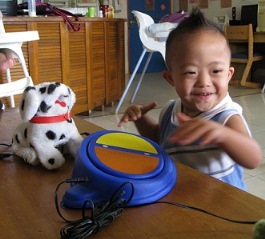Switches
For person with a disability, a tap of a switch can open the door to the world of function and communication. This page will give an overview of switches, talk about figuring out what type of a switch a person needs, and describe switch features, types, and accessories.
What You Should Know About Switches
A switch is a tool for making (or breaking) the connections in an electrical circuit. Switches can help a person who lacks the fine motor control to use devices or machines such as toys, blenders, wheelchairs, computers, environmental controls, or augmentative communication devices.
Children, youth, and young adults with different types of conditions and disabilities can use switches. Some of these conditions are:
- Cerebral palsy
- Paralysis/spinal cord injuries
- Multiple sclerosis
- Arthritis
- Autism
- Speech impairments
- Visual impairments
Switches come in many sizes, shapes, colors, and types. Switches have two classifications: simple and specialty . Simple switches are switches which work through a touch or tap. Specialty switches make a connection by something other than touch, such as breath, motion, infrared, sound, and/or fiber optic.


Simple (touch) switches come in different sizes, shapes, and colors, and can work with a light touch of less than an ounce to a heavier touch greater than 20 ounces. Some simple switches are made from one single switch plate; others may be made of two to five switch sites.
Specialty switches are most often used for those people who are not able to push a simple switch. Specialty switches are more costly and need specialized mounting. A breath or pneumatic switch is a mechanical switch which is activated through breath control. Motion or movement switches detect any type of motion including an eye blink or muscle twitch. Proximity switches react to movement in a chosen area. Infrared and optic fiber switches use light rays and can be used with any body movement. Sound activated switches react to sounds from a whisper to a loud clap.
Switches can help users with daily activities such as:
- Using a motorized wheelchair
- Opening doors to a home
- Using kitchen appliances
- Turning on and off lights, televisions, etc.
- Using computers
- Communicating
Evaluating for Switch Use
A switch is a tool for making a functional outcome. The first step in switch evaluation is to determine the needs of the person. This may range from:
- Activation of toys
- EDL (electronic aids to daily living, often referred to as environmental controls)
- Computer access
- the need to operate multiple devices through one system
The needs of the person are the basis of the evaluation.
In the next step, knowledge and history of the person should be logged. This includes:
- Medical diagnosis
- Physical abilities
- Limitations
The medical diagnosis will give information about the course (type of disorder - muscular, skeletal, etc.) and prognosis (slow/fast) of the disorder. A physical exam of the person should be done to check the body position to allow maximum performance. The doctor will be able to tell you about the strengths and limitations of the person while the occupational therapist, physical therapist, or assistive technology expert* will know more about the physical requirements of the equipment. All of this information together will help determine the types of switches to best meet the person’s needs.
*Assistive technology experts can be found through Disability Resources, and the Rehabilitation Engineering and Assistive Technology Society of North America (RESNA).
Switch Features
Switches can have many different features to meet the needs of the user. Some users will have a specific need for the switch, some may need a certain size, and sensory issues should be considered when choosing texture, material, output and feedback.
- Size (overal dimensions, activation contact area)
- Shape (round, square, oval, etc.)
- Texture of contact area (smooth, bumpy, hard, soft, etc.)
- Material (best if sturdy and cleanable; plastic metal, wood, etc.)
- Switch feedback (auditory, visual, vibratory)
- Output choices (digital or synthesized speech; printed; LCD display; Braille printout, etc.)
- Environmental control (lights, doors, computer, thermostatic, radio, TV, etc.)
- Recreational use (for computer games, toys, adapted recreational activities, etc.)
- Selection method options (Morse Code, encoding, directed scanning, linear scanning, step scan, row/column scan, auditory scanning, etc.)
Types of Switches
There are many switches for all types of contact and just about any body movement. Some of the more common switches are listed below. A great website to find detailed switch information is Assistive Devices (NICHD). A list of manufacturers is in "Resources" below.
- Pressure switches require pressure on the surface activate.
- Lever switches require pressure on the end of a lever.
- Touch switches are activated by touching a projection in any direction.
- Joysticks can be moved in different directions to provide control of wheelchairs or computers or set up as a switch for four devices.
- Sip-n-puff switches are activated by pressure changes by soft and hard sips and puffs into a mouth tube.
- The SCATIR (Self-Calibrating Auditory Tone Infrared) switch is a multipurpose versatile switch that can be activated by eye blink, or eyebrow, finger, head or facial muscle movement.
- Muscle twitch switches are activated by muscular movement sensed on the skin.
- An eye blink switch is activated by each eye blink or double eye blink and can control communication devices, toys or computers.
- Proximity switches work through electromagnetic force received from proximity to a body part.
- String switches are activated by pulling and letting go of a three-inch loop of string.
- Tongue switches use a dental type plate put on the roof of the mouth that has range of pressure sensitive spots activated by the tongue.
- Directional switches have five pressure spots that operate as separate switches to control more than one device or for devices that call for more than one switch.
- Joystick with Pad switches are like directional switches because they can be used to control any device that calls for five single switches or can be changed to control up to five devices with a single switch.
- Rocker switches are a type of lever switch with a left and right side allowing the activation of two switches.
- Squeeze switches are activated by gripping with the hand onto a cylindrical or other type of handle.
Left photo: Example of a simple pressure switches on universal switch mountings, Photograph by Inclusive TLC (Technology Learning Communication).
Center photo: Example of a sip-n-puff switch. Photograph by Therafin Corporation.
Right photo: Example of a tongue switch. Photograph by Prentke Romich Company.
Switch Accessories
There are many accessories that can be used with switches to make them more helpful. Some of these accessories are:
- Battery interrupters are used to link a switch with a battery-operated toy or appliance. You can find them online or in specialty battery stores or they can be homemade. A battery interrupter has a metal conductor that fits between the battery and the battery chamber and the other end has a switch plug. This lets a range of switches be plugged into the device. Fits AA/AAA or C/D batteries.
- Wireless switch transmitters let a switch work a device without a direct link between the switch and the appliance.
-
Switch latch timers act as a link between the switch and
the device being used and can run several functions by tapping the switch.
They are made for AC (household current) or DC (battery current):
- Momentary or direct - the device runs while the switch is activated or the connection is “closed.” This is useful for teaching basic cause and effect or short actions such as turning on a blender for a few seconds.
- Latched - switch activation will turn the device “on” and a second activation turns the device “off.” This is useful for those who are not able to keep fixed activation of a switch or for those actions where an “on/off” switch is needed such as turning on and off a light.
- Timer feature – has a set length of time (in seconds or minutes) that the device will run before needing re-activation. This is useful for when the person is not able to keep contact with the switch, so it turns “on” for a set period of time, but needs reactivation to turn back “on” again.
- Switch mounts can be made to fit or are commercially available. The purpose of a mount is to place the switch where it can be reached in the same way each time. Mounts can be “low tech” such as placing a switch on a non-skid pad (made of Dycem, plastic drawer liners, Velcro) or mounting the switch on a table top or tray. A mount with an angle can be put together with plywood or cardboard. Commercial mounts are made to be set up at different angles and can be attached to many surfaces such as wheelchairs, tables, beds, and more.
- A switch tester makes a sound when a working switch is plugged into it, showing that the switch works.
Resources
Information & Support
There are many commercial sites that have retail switches. Some examples are listed below. The Medical Home Portal is not endorsing any of these commercial companies by listing them here.
For Parents and Patients
Adaptive Switch Labs
A commercial site offering switches, cables, adapters, and other equipment and technology solutions; helpful for learning
about and purchasing different types of specialty switches.
AbleNet - Switches
A commercial site offering switches including specialty, timer, tilt, soft, multiple, and other switches and accessories.
Inclusive TLC (Technology Learning Communication)
A commercial site offering technology and software for educational use including switches, software, communication aids, computer
accessories, and more; offers a lot of information and options for switches.
RJ Cooper & Associates
Commercial site: iPad & computer accessories and gadgets for people with disabilities, including switches. Includes reviews,
tips, and personal experience with equipment.
Enabling Devices
A commercial site that evaluates and suggests assistive technology for individual needs including switches, computer aids,
mobility devices, toys, and more.
Zygo Industries, Inc.
A commercial site offering communication systems, switches, and other technology products.
Infogrip
A commercial site offering communication devices, computer devices, switches, and more.
Therafin Corporation
A commercial site offering wheelchairs, accessories, daily living aids, and more; provides information about switch-mounting
and has a downloadable catalog of products.
Services for Patients & Families in New Mexico (NM)
| Service Categories | # of providers* in: | NM | NW | Other states (3) (show) | | NV | RI | UT |
|---|---|---|---|---|---|---|---|---|
| Assistive Technology Equipment | 47 | 36 | 46 | 44 | 72 | |||
For services not listed above, browse our Services categories or search our database.
* number of provider listings may vary by how states categorize services, whether providers are listed by organization or individual, how services are organized in the state, and other factors; Nationwide (NW) providers are generally limited to web-based services, provider locator services, and organizations that serve children from across the nation.
Authors & Reviewers
| Author: | Amy Henningsen, OTR/L ATP |
| Reviewers: | Tina Persels |
| Craig Boogaard, Technical Support Specialist | |
| Marilyn Hammond, Ph.D. |


 Get Help in New Mexico
Get Help in New Mexico